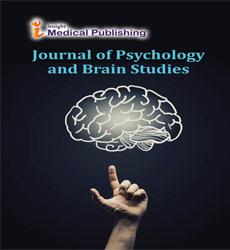Young Parents Battling with Postpartum Depression
Robert Coin*
Department of Psychology, University of Southern Queensland, Springfield Central, Australia
- *Corresponding Author:
- Robert Coin
Department of Psychology
University of Southern Queensland, Springfield Central, Australia
E-mail: coinrob23@yahoo.com
Received Date: December 07, 2021; Accepted Date: December 21, 2021; Published Date: December 28, 2021
Citation: Coin R (2021) Young Parents Battling with Postpartum Depression. J Psychol Brain Stud Vol. 5 Iss No.12:60.
Depression is a prominent cause of disability globally, with postpartum depression being a long-standing public health concern that affects women, their children, and partners worldwide. While both pharmacotherapy and psychotherapy are effective treatments for women with mood disorders, psychotherapy is three times more common than medicine. Many postpartum depression women go untreated, with just about 20% seeking help. As a result, new ways to treatment delivery are necessary to promote equal access and outcomes, including the use of non-specialist health workers, such as nurses, who are equipped to give effective psychotherapy in mental health services. Postpartum Depression is a major depressive episode, although its underlying pathophysiology is assumed to share some characteristics with major depressive episodes outside of the perinatal period. For example, acute, chronic, and even longterm.
Pregnancy is one of the most important experiences a woman can have, including extraordinary and critical biological and emotional changes. In contrast, the post-partum period is characterised by major mood disorders, with pertinent data indicating that around 13% of all admissions to psychiatric clinics occur during this time; also, women are 70 times more likely to commit suicide during this time. Postpartum melancholy (baby blues), postnatal depression (PND), and postpartum psychosis are the most prevalent mental disorders that arise upon childbirth (PP). In general, postpartum depression is a kind of clinical depression that affects 10%– 15% of women, with only one in every four instances being detected and treated. PND is one of the most frequent causes of maternal distress, and it is a significant public health issue that affects millions of women. Postpartum depression is a complex combination of physical, emotional, and behavioural changes that occur after childbirth and are ascribed to the chemical, social, and psychological changes involved with childbirth. The birth of a child can elicit a range of strong emotions, from excitement and joy to fear and anxiety.
However, it can also lead to something unexpected: depression. After childbirth, most new mothers have postpartum "baby blues," which include mood changes, crying episodes, anxiety, and problems sleeping. Baby blues often begin two to three days after delivery and can continue up to two weeks. Postpartum depression is extremely prevalent. After giving birth, as many as 50 to 75 percent of new mothers have "baby blues." After giving birth, up to 15% of these women will have a more severe and long-lasting depression known as postpartum depression. One in every 1,000 women develops postpartum psychosis, a more dangerous disorder. Postpartum depression does not imply that a person does not adore their child. It is a mental health disorder that can be treated. Anyone experiencing symptoms should consult a doctor right away.
PP is a very rare condition, with an incidence rate of 0.1 percent - 0.2 percent, and it usually occurs between two days and two weeks after birth. It is critical to distinguish between "baby blues," serious depression, and psychosis. PND is classified as a "depressive illness with peripartum onset" in the fifth edition of the Diagnostic and Statistical Manual of Mental Disorders, which is defined as any time during pregnancy or the first four weeks after birth. All of the aforementioned diseases have a significant and direct impact not only on the child, regardless of age, but also on family cohesion.
Open Access Journals
- Aquaculture & Veterinary Science
- Chemistry & Chemical Sciences
- Clinical Sciences
- Engineering
- General Science
- Genetics & Molecular Biology
- Health Care & Nursing
- Immunology & Microbiology
- Materials Science
- Mathematics & Physics
- Medical Sciences
- Neurology & Psychiatry
- Oncology & Cancer Science
- Pharmaceutical Sciences
